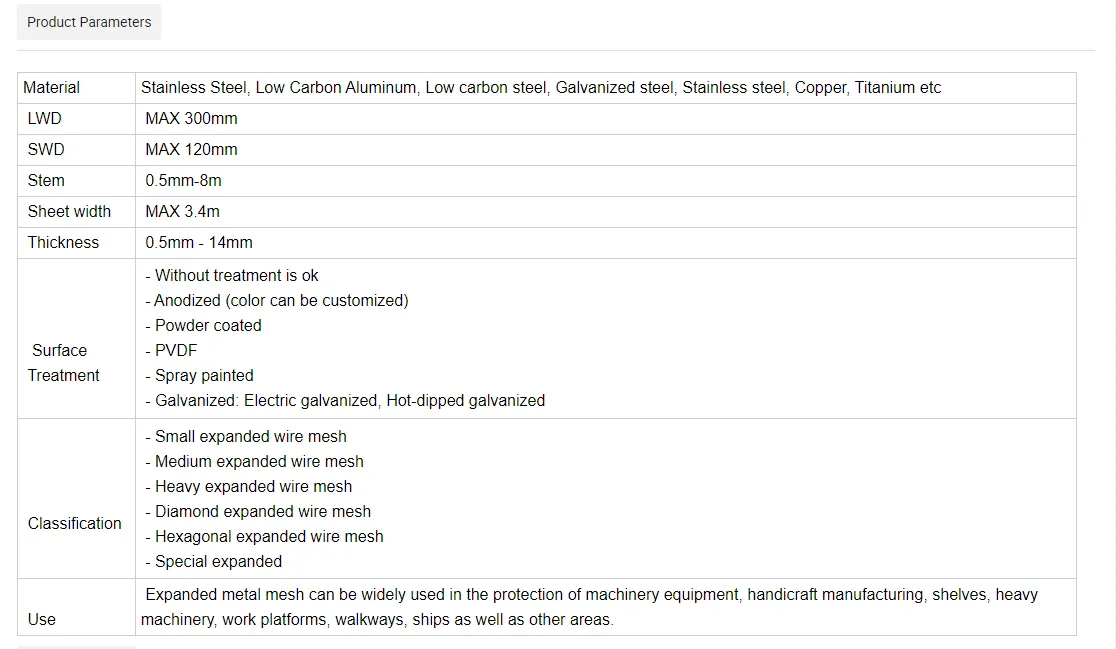Understanding Steel Perforated Sheet Metal Applications and Advantages
Steel perforated sheet metal is a versatile material widely used across various industries due to its unique aesthetic appeal and functional properties. It is made by puncturing flat sheets of steel with a series of holes or patterns, allowing for various applications in architecture, construction, industrial processes, and more. This article delves into the characteristics, applications, and advantages of steel perforated sheet metal.
What is Steel Perforated Sheet Metal?
Steel perforated sheet metal is essentially a flat steel sheet that has been processed to create a pattern of holes, slots, or other designs. The perforations can vary in shape (round, square, or custom shapes) and size, depending on the intended use and the requirements of the project. This type of sheet metal is available in different thicknesses and sizes, providing flexibility for various applications.
Key Characteristics
1. Strength and Durability Steel is known for its high tensile strength, making perforated steel sheets durable and able to withstand significant weight and pressure. This makes them suitable for tough environments and heavy-duty applications.
2. Lightweight Despite their strength, perforated steel sheets are relatively lightweight due to the removal of material in the perforation process. This makes them easier to handle and install compared to solid steel sheets.
3. Design Versatility One of the most appealing features of perforated sheet metal is its design flexibility. Architects and designers can use various hole patterns to achieve desired aesthetics while maintaining functionality, allowing for creative designs in buildings, facades, and interiors.
4. Ventilation and Light Filtration The holes in perforated sheets allow airflow and light to pass through, making them ideal for applications where ventilation and natural lighting are desired. This feature is essential in many industrial processes, as well as in architectural designs.
5. Corrosion Resistance Many steel perforated sheets are treated with coatings to enhance corrosion resistance, ensuring longevity and performance in harsh environments.
Applications of Steel Perforated Sheet Metal
steel perforated sheet metal

1. Architectural Design Architects use perforated steel sheets for cladding and facades, providing both an aesthetic appeal and functional benefits like ventilation and sun control. They can be used in modern buildings to create stunning visual effects while enhancing energy efficiency.
2. Industrial Applications In industrial settings, perforated metal sheets are commonly used for manufacturing equipment, protective barriers, and safety guards. They allow for efficient airflow, thereby helping to maintain temperature control and reduce dust accumulation.
3. Acoustic Panels Perforated sheets can also serve an important role in sound management. When used as acoustic panels, they can help control sound reflection and absorption, creating more pleasant environments in offices, theaters, and other spaces.
4. Food and Beverage Industry In the food industry, perforated metal is often used for items such as trays, filters, and conveyors, as the perforations allow for easy drainage and airflow while maintaining structural integrity.
5. Furniture Design Modern furniture designers are increasingly incorporating perforated metal into their creations. The unique patterns and light weight of perforated sheets make them ideal for innovative furniture designs, including partitions, tables, and seating.
Advantages of Using Steel Perforated Sheet Metal
- Cost-Effectiveness Steel perforated sheets can be a cost-effective solution compared to other materials due to their strength-to-weight ratio and the longevity they provide, reducing the need for frequent replacements.
- Customization Perforated sheets can be customized to meet specific project requirements, allowing for unique designs and functionality tailored to individual needs.
- Eco-Friendly Steel is 100% recyclable, making perforated steel sheets an environmentally friendly option for sustainable construction and manufacturing practices.
- Easy Installation The lightweight nature of perforated sheets makes them easier to transport and install, saving time and labor costs in construction projects.
In conclusion, steel perforated sheet metal is an invaluable resource in modern construction and industrial applications. Its combination of strength, lightweight versatility, and design capabilities makes it a preferred choice for architects, engineers, and designers seeking innovative solutions. As technology and design philosophies continue to evolve, the use of perforated sheet metal is likely to expand further, paving the way for even more creative applications in the future.
-
Why Galvanized Trench Cover Steel Grating Resists Corrosion
NewsJul.10,2025
-
The Versatility and Strength of Stainless Expanded Metal Mesh
NewsJul.10,2025
-
Load Calculations in Steel Grating Platforms
NewsJul.10,2025
-
Keeping Pets and Kids Safe with Chicken Wire Deck Railing
NewsJul.10,2025
-
Hole Diameter and Pitch for Round Perforated Metal Sheets
NewsJul.10,2025
-
Aluminium Diamond Mesh in Modern Architecture
NewsJul.10,2025
Subscribe now!
Stay up to date with the latest on Fry Steeland industry news.

